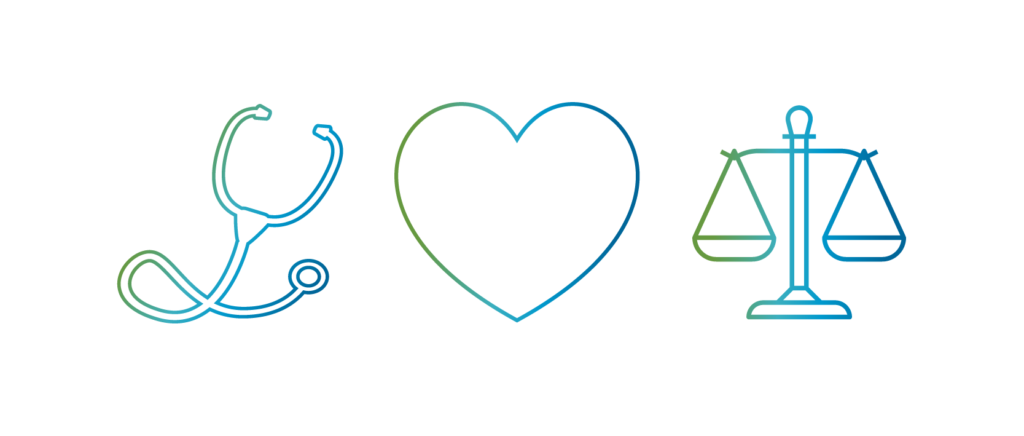June 22, 2020
Black Health Matters: How We Can Improve Health Equity for Black Communities

Racial inequities can be found throughout every area of our society, including healthcare. Health disparities are disproportionally impacting Black communities compared to the general population, and are killing Black individuals at alarming rates.
The U.S. faces significant racial disparities in chronic health conditions, mental illness, insurance coverage, and mortality:
- Black individuals have higher rates of diabetes, hypertension, and heart disease than other groups, and also show a higher death rate as a result of these conditions.
- Approximately 11% of Black individuals are not covered by health insurance, compared with about 7% for whites.
- Only one-in-three Black individuals who need mental health care receive it.
Barriers to access and quality of care for Black Americans are due to a variety of factors, including social stigma and racial bias, distrust of the health care system, lack of providers from diverse racial/ethnic backgrounds, and lack of insurance.
Identifying and implementing effective strategies to eliminate these disparities should be made an urgent priority for the health and well-being of our whole community. We must all take action to ensure that Black Americans are treated equitably within our healthcare system and can achieve whole health.
Understand the health of our population.
Prioritizing population health is fundamental and critical to reducing inequity. Cascadia’s Population Health team supports staff and clients in achieving improved, equitable health outcomes for the people we serve through intervention, education, and advocacy.
The Population Health team provides education around health disparities that exist in healthcare in general, as well as in the population Cascadia serves. This information is used to create specific programming that addresses disparities, including diabetes, chronic pain, and mental health. Using qualitative and quantitative measures, as well as direct feedback from affected populations, the team collects data that helps determine the efficacy of interventions, impact on disparities, and any next steps to improve care for high-risk populations. The team also makes it a priority to share information with other organizations both locally and nationally, so any learnings or successes can help address health disparities on a larger scale.
Improve access to integrated care.
Cascadia wants to reduce health inequities by considering the needs of the whole person. We know that physical and mental health are inextricably linked, and if we are to make significant improvements in the health of our Black communities, we need to ensure they are receiving comprehensive, integrated care.
Cascadia incorporated primary care into its continuum of care in 2017, and clients who’ve since received integrated care experienced average reductions in potentially preventable emergency department utilization (18%) and hospitalizations (23%). These dramatic reductions represent a significant step towards health equity. When individuals have poor access to healthcare or are marginalized from traditional avenues of care, they often go to the emergency department as a last resort when health has declined considerably – having access to primary care and additional services helps intercept that.
Celebrate and promote diversity within our own communities.
Only when we promote and support the diversity of our community can we build bridges to trust, respect, and understanding across cultures. Cascadia’s Equity, Diversity, and Inclusion Department work hand-in-hand with many external groups, including marginalized people and minorities, to build trust with a variety of communities. We will continue to understand, listen, and build those partnerships both on a personal and professional level.
Improve access to healthcare and services in economically impacted and diverse neighborhoods.
It’s an unfair reality of many cities that areas with the highest poverty rates also tend to have the highest percentages of people of color. Increasing access to healthcare and services in the areas of greatest need will inevitably improve health outcomes for these communities. In Portland specifically, the highest rates of poverty are now concentrated in Outer East Portland, which is why Cascadia is building Centennial Place – an affordable housing complex– to provide better care and access to services to our community members in this area. Additionally, plans for Centennial Place include forming partnerships with culturally specific, community-based organizations to ensure Black community members are receiving respectful, effective, and impactful care.
Offer culturally relevant care and providers with diverse backgrounds and ethnicities.
Understanding cultural differences and putting that understanding into action play important roles in ensuring an equitable and effective healthcare system. We need to hire a more diverse force of healthcare professionals with the knowledge, skills, and attitudes required to bridge cultural, ethnic, and language gaps between patients and providers. By doing so, we can continue to breakdown the decades of mistreatment and mistrust Black Americans have experienced in the medical community.
Recognize structural and institutional history that perpetuates health inequity.
To build a better future, we must acknowledge the past. We cannot effectively move forward if we do not collectively recognize the failures of our system and the impacts those failures have had on our Black community members. All areas of our community, including health organizations, government bodies, private businesses, and individuals, must band together to work towards a new reality.
Cascadia recognizes the strength and resilience of the Black community and knows that there is so much work to be done to ensure their equitable treatment in healthcare. While there is no single solution to the systemic challenges of racism, there are many changes we can make right now to improve health outcomes. We are at a pivotal moment in history. Improvements in health happen not only in clinics or health centers, rather, whole health is built within ourselves, our homes, workplaces, and the greater community.
